Frederick Thomas Hudson, 1803 - 1884
Alfred Hudson, 1842 - 1919
William Hudson, 1845 - 1919
F.T. Hudson (1828 - ca. 1862)
Hudson and Son (ca. 1862 - into the twentieth century)
by Brian Stevenson
last updated Febuary, 2016
F.T. Hudson began his Greenwich, London, optical business in 1828. It appears that his major products were eyeglasses, expanding to include magnifiers and other instruments over the years. A notebook he kept between 1849 and 1864, while a member of the Microscopical Society of London / Royal Microscopical Society, implies that F.T. Hudson was not an expert manufacturer of microscopes. However, his notebook is full of references to slide making and contains several records of his donating slides to the Society. Frederick exhibited microscope slides only at the 1851 London Exhibition, as did also the father-son partnership at the 1862 London Exhibition.
This information suggests that many of the microscope slides bearing the labels of F.T. Hudson were prepared by Frederick. Some with Hudson and Son labels may also have been his productions. Slides with F.T. Hudson labels date to before ca. 1860, and are relatively scarce. Hudson and Son was in business from about 1860 until after the turn of the twentieth century, and are moderately common (Figure 1).
From what is know of the Hudson businesses, it is likely that microscopes labeled by F.T. Hudson were not made by him (Figure 2). The variety of items retailed by Hudson and Son suggests that they were competent manufacturers of scientific equipment, and quite likely manufactured the microscopes and other instruments that they sold (Figures 5, 6 and 7).
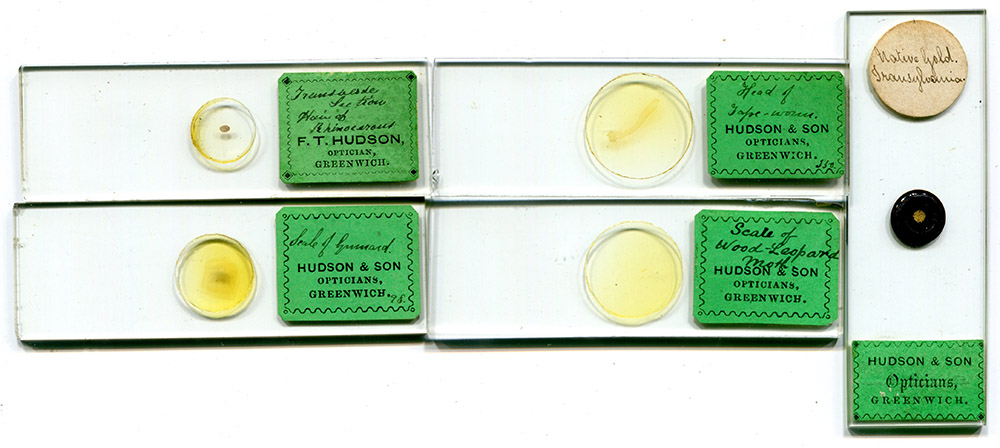
Figure 1.
Examples of microscope slides from F.T. Hudson, and Hudson and Son. It is probable that F.T. Hudson made many of the slides sold under his name. His sons/son are more likely to have brought in slides from outside preparers, although those with specimen descriptions written on the business labels may have been produced in-house.
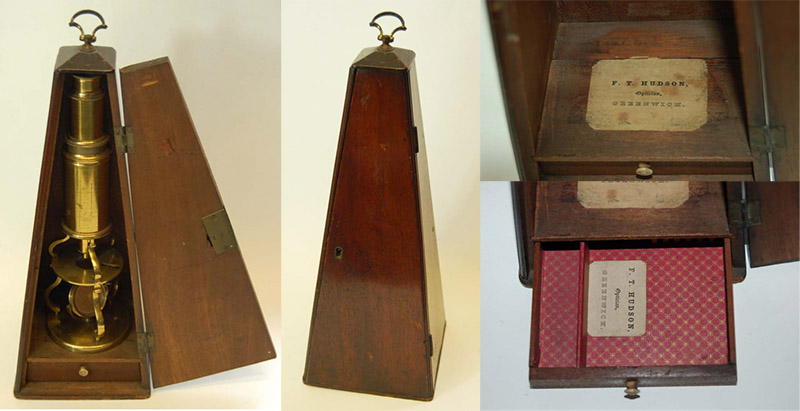
Figure 2.
A Culpeper pattern microscope, with labels from F.T. Hudson. Adapted from an internet auction site for nonprofit, educational purposes.
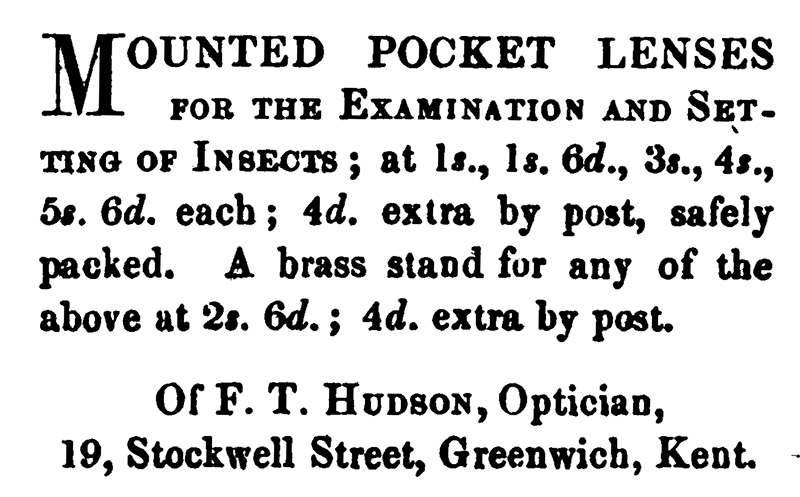
Figure 3.
An 1854 advertisement, indicating that F.T. Hudson made simple magnifiers, at least. Hudson was an amateur entomologist, which may have prompted him to expand his product line in that direction.
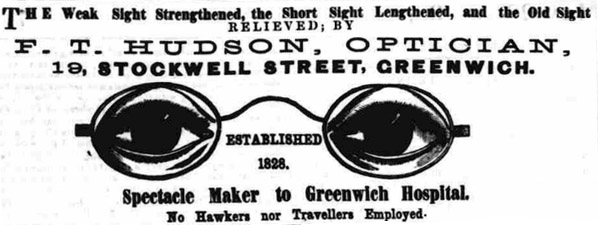
Figure 4.
An 1859 advertisement from F.T. Hudson, noting that the business was established in 1828. Within three years, Frederick had partnered with his sons Alfred and William to form Hudson and Son.
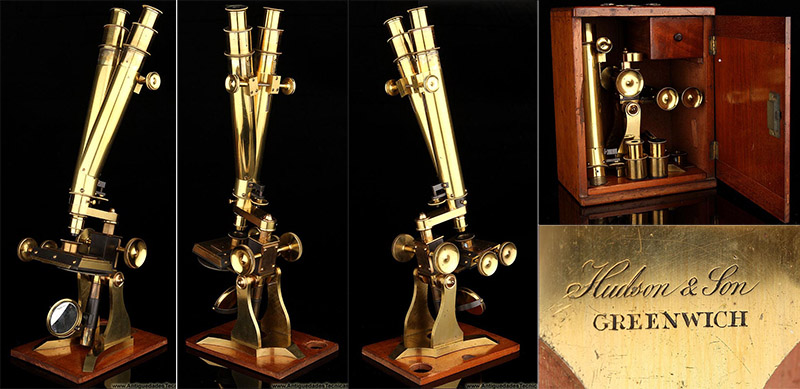
Figure 5.
Binocular microscope, by Hudson & Son. Adapted from www.antiguedadestecnicas.com for nonprofit, educational purposes.
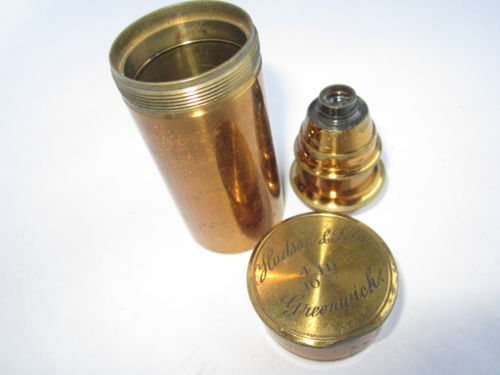
Figure 6.
A 4/10 inch microscope objective lens and canister, by Hudson and Son. Adapted from an internet auction site for nonprofit, educational purposes.

Figure 7.
An artificial horizon. The instrument is engraved “Hudson and Son, Greenwich”, and their trade label is glued inside the case. Adapted from an internet auction site for nonprofit, educational purposes.
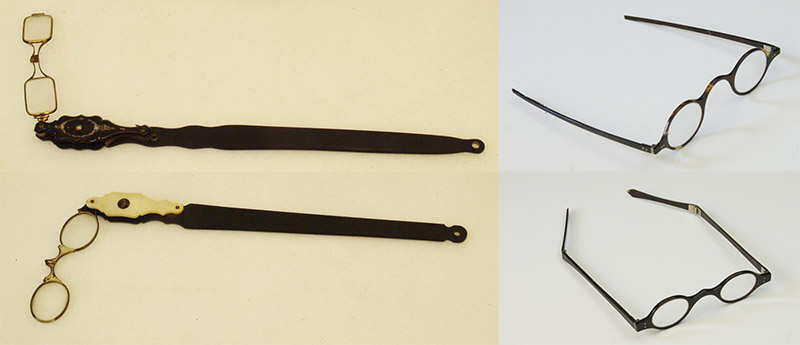
Figure 8.
Spectacles and lorgnettes, all by Hudson and Son. Adapted for nonprofit, educational purposes from http://collectionsonline.nmsi.ac.uk/detail.php?type=related&kv=105146&t=people
Frederick T. Hudson was born March 13, 1803, in Birmingham, Warwickshire. His father was also a spectacle maker, so it is likely that he taught Frederick the trade. The parish record of Frederick’s 1861 marriage list his fathers name as William Fox Dowell. The reason for the different surnames is not known. Frederick was christened when 16 years old, on April 24, 1819, at St. Marylebone, London.
According to later advertisements (Figure 4), Frederick established an optician’s shop in 1828. It was then located on Greenwich Road.
He also married that year, to Mary Lettis, on November 16. The pair had 8 known children, first five girls, followed by 3 boys. The last two children, Alfred and William, eventually took over their father’s business. The elder son, Frederick, died in 1843, when only 2 years old. Relating that son, the UK’s Science Museums Group is obviously incorrect in describing Hudson and Son as the “partnership between Frederick T. Hudson and his son, Frederick” (http://collectionsonline.nmsi.ac.uk/detail.php?type=related&kv=105146&t=people).
The 1841 census indicates that Hudson still lived and worked on Greenwich Road. The parish record of Frederick’s 1843 burial lists the family’s address as Stockwell Street, Greenwich. The family home and optician’s business remained on Stockwell Street into the twentieth century.
Frederick was elected to membership in the Microscopical Society of London (later Royal Microscopical Society) on March 28, 1849. Beginning the previous February, he kept a diary of his attendance of Society meetings and functions. Gerard Turner described this diary and detailed its contents in a 1994 paper in the Quekett Journal of Microscopy. Frederick mentioned a number of incidents, such as his purchase from Smith & Beck, of “a students microscope with 2/3 object glass and extra eye piece and polarizing apparatus” on March 16, 1849, and “saw the Lords Prayer written on glass within the space of 2/100 of an inch by Mr. Peters” on February 11, 1854. There are many places throughout the diary in which Hudson made notes on slide-making techniques, from arranging insect legs to mounting chemicals to ideas on sealants to affix cover slips. On April 18, 1851, he ponders to himself, “Does Mr. T(opping) stain his sections of vegetables?”. He noted “Mr. Claudet’s price of slips” on April 2, 1849 as 4 shillings per gross. There are numerous notations of “objects to mount”, followed by lists – these were, presumably, either items he acquired at meetings or ideas he got from seeing other people’s slides. Hudson also donated numerous slides to the Society. As noted above, Hudson’s diary is clearly that of an active slide-maker, supporting the idea that he made at least some of the slides that he sold at his shop.
Hudson displayed products at the 1851 London International Exposition, in Class 10: Philosophical, Horological, Musical, and Surgical Instruments. This is the same class in which makers of microscopes and other apparatus showed off their devices. Hudson, however, displayed only “Animal, vegetable, and mineral tissues, and structures, prepared for the microscope”.
On February 7, 1853, Frederick was elected to membership in the Royal Entomological Society. The minutes of his election noted that he was “a Subscriber to the Society” before joining.
Being skilled at grinding glass for spectacles, it would not have been difficult for Hudson to expand his repertoire to include simple magnifiers, such as that advertised in 1854 (Figure 3). There is written evidence of his skills as a machinist, too. He built a magnetic microscope stage and object carrier for George Busk in 1854, by milling into the stage and attaching magnets, and machining a slide-holder with an iron base.
Frederick’s wife, Mary, died in early 1858. He remarried on November 13, 1861, to Mary Elizabeth Dunkin, a widow of roughly his same age.
The advertisement shown in Figure 4 states that the optical business was named F.T. Hudson in 1859. When the business exhibited at the 1862 London Exhibition, its name had changed to Hudson and Son during the intervening 3 years. Later business records, described below, indicate that both sons Alfred and William were partners. Although a few reference books call them “Hudson and Sons”, the majority of records, including official documents, show only the singular, “Son”. The reason for this quirk in naming is not known - perhaps they liked the sound of the repeating “son”.
Their display at the 1862 Exhibition again indicates that their important products for display were microscope slides: “Animal, vegetable, and fossil tissues and structures, &c.”
William Hudson joined the Microscopical Society of London on December 14, 1864. His father terminated his own membership that same year. Turner (1994) suggests that they may have felt that one membership was enough, since a copy of each Society publication would come to their home anyway. It is also reasonable that William, as owner of the business, would benefit from interactions with the elite of microscopy. The other owner, older brother Alfred, did not join, although he probably could attend meetings as a guest. Frederick, who turned 61 that year, may have retired. He was certainly out of the business at the time of the 1871 census, when he, his new wife Mary, and an unmarried daughter lived in Saint Clement, Cornwall.
The 1871 census also records both Alfred and William living at the family home and shop on Stockwell Street, with two other unmarried sisters and a step-brother (from Mary’s first marriage).
The partnership between Alfred and William broke up in March, 1874 (Figure 9). William continued the business alone.
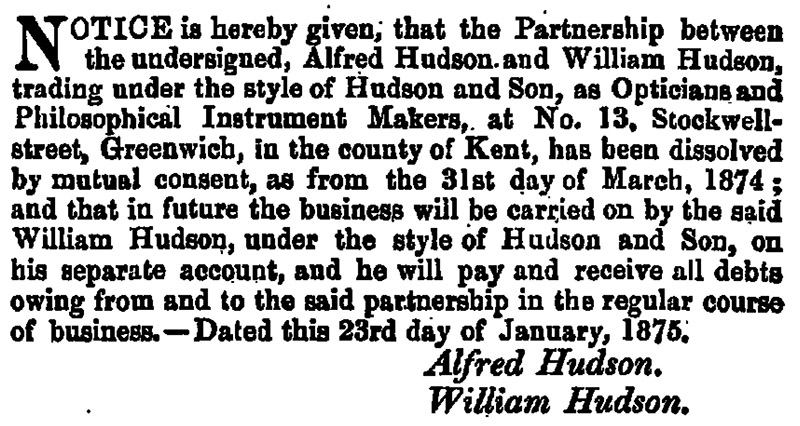
Figure 9.
Notice of the dissolution of the Hudson and Son partnership of Alfred and William, and the assumption of the company by William.
The 1875 membership list of The West Kent Natural History, Microscopical & Photographic Society indicated that Alfred had moved from the family home, to 13 Royal Place, Greenwich. The 1881 census stated that he was still a “mathematical instrument maker”. Alfred’s home was only a 6-7 minute walk from the Hudson shop on Stockwell Street, so he may have been an employee of his brother, or, he may have opened his own shop there. However, by 1883, Alfred had moved across the Thames to Middlesex: he was recorded in a business directory of that year as operating the Alfred Hudson & Co. optical and scientific instrument business. Frederick Hudson died in 1884, and the probate of his will provides similar information: “The Will of Frederick Thomas Hudson formerly of Stockwell-street Greenwich and afterwards of Nautilus Villa Lion-road Bexley but late of 4 Oxford-villas Salisbury-road Bexley all in the County of Kent who died 15 June 1884 at 4 Oxford-villas was proved at the Principal Registry by Alfred Hudson of 34 Hatton-garden in the county of Middlesex Optician the Son and Martha Hudson of 4 Oxford-villas Spinster the Daughter the Executors. Personal Estate £1245 19s 5d”. Alfred’s business went bankrupt in late 1885. The 1891 census listed Alfred as still living in Middlesex, on Barry Road, Camberwell, and still employed as an optician. Presumably, he was an employee of another optical business. A few years afterwards, Alfred moved to Stone, Kent, and took a job as an inspector with the Water Works. He held that occupation during the 1901 and 1911 censuses, and died in Stone during 1919.
The variety and quality of the apparatus known to bear the name of Hudson and Son suggest that William expanded the instrument manufacturing aspect of the business. His name on the canister of an microscope objective lens (Figure 6) is highly suggestive of the business actually having made the optics, at least. An 1883 business directory listed Hudson and Son as being “mathematical instrument makers”. A 1905 Electrical Trades Directory listed, “Hudson & Son, Electrical Instrument Makers, 15 and 16, Stockwell-st, Greenwich, London, S.E. (162 Deptford)”.
William married around the time he became sole owner. He and his wife, Hannah, had three girls, then two sons. As did William’s eldest brother, their eldest son died in infancy. The surviving son, Walter Frederick Fox Hudson followed in his father’s footsteps. The 1901 census listed the 17 year old Walter as being an “optical engineer”, and the 1911 census lists him as a “philosophical instrument maker”.
William Hudson died on April 12, 1919.
Turner (1994) suggested that Hudson and Son remained in business until 1962.
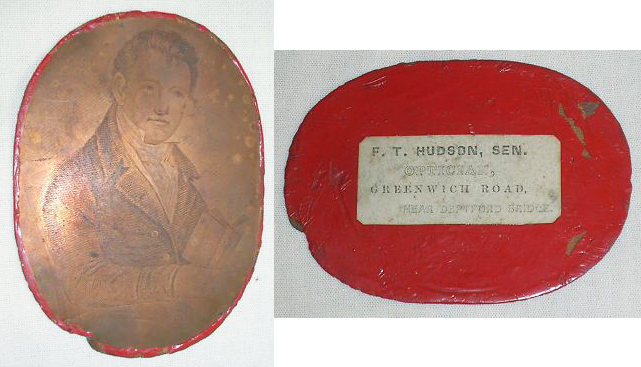
Figure 10.
A brass plate, engraved with the figure of a man who is holding a book. It is backed with sealing wax, and a label from F.T. Hudson. The address on the label is Greenwich Road, where Hudson operated from 1828 until the early 1840s. His name is written as F.T. Hudson Sen (senior), suggesting that it dates from the time when Frederick’s first son, Frederick, was alive: 1840-1843. The purpose of the brass plate is not known - is it a printing plate, a portrait of Hudson, or something else? Any suggestions will be very welcome. Images adapted for nonprofit, educational purposes from an internet auction site.
Resources
W. Archdeacon's Greenwich & Woolwich directory (1852) “Hudson, F.T., optician, Stockwell-street, Greenwich”, page 42
J.A. Berly's British, American and Continental Electrical Directory and Advertiser (1883) “Mathematical Instrument Makers: Hudson, Alf. & Co., 34, Hatton-garden, E.C. … Hudson & Son, Stockwell-st, Greenwich, S.E.”, page 68, and “Opticians: Hudson, Alfred & Co., 34, Hatton-garden, E.C. … Hudson & Son, Stockwell-st, Greenwich, S.E.”, page 73
Bracegirdle, Brian (1998) Microscopical Mounts and Mounters, Quekett Microscopical Club, London, pages 54 and 146, Plate 21-N
Bracegirdle, Brian, and James B. McCormick (1993) The Microscopic Photographs of J.B. Dancer, Science Heritage, Chicago, slide 255 shows a Dancer microphotograph with a Hudson and Son secondary label, page 212
Burial record of Frederick Hudson (1843) Parish records of St. Alphege, Greenwich, accessed through ancestry.co.uk
Busk, George (1854) Description of a magnetic stage to the microscope, Transactions of the Microscopical Society of London, New series, Vol. 2, pages 280-281
Christening record of Frederick Thomas Hudson (1819) Parish records of St. Mary’s, Marylebone, accessed through ancestry.co.uk
Electrical Trades Directory (1905) page 931
England census, birth, marriage, and death records, accessed through ancestry.co.uk
The Entomologist’s Annual (1859) “List of British Entomologists: Hudson, F.T., 13, Stockwell Street, Greenwich, S.E. British Lepidoptera”, page 17
The Entomologist’s Weekly Intelligencer (1854) Advertisement from F.T. Hudson, Vol. 1, page 152
The Gardeners’ Chronicle (1849) Society news (election of F.T. Hudson to the Microscopical Society of London), Vol. 9, page 219
Great Exhibition, Official Catalogue (1851) page 66
London Gazette (1875) page 321
London Gazette (1885) page 4252
Marriage record of Frederick T. Hudson and Mary Lettis (1828) Parish records of St. Dunstan in the West, accessed through ancestry.co.uk
Marriage record of Frederick T. Hudson and Mary Elizabeth Dunkin (1861) Parish records of St. Andrew Barnsbury, accessed through ancestry.co.uk
Official Catalogue: Industrial Department (1862) page 47
Probate of Frederick Thomas Hudson (1884) accessed through ancestry.co.uk
Probate of William Hudson (1919) accessed through ancestry.co.uk
Science Museum Group (accessed February, 2016) http://collectionsonline.nmsi.ac.uk/detail.php?type=related&kv=105146&t=people
Transactions of the Entomological Society of London (1853) Election of F.T. Hudson, Vol. 2, page 93
Transactions of the Microscopical Society of London (1864) Election of William Hudson, Vol. 13, page 68
Turner, G. l’E. (1994) Frederick Thomas Hudson’s microscopical diary, 1849-1864, Quekett Journal of Microscopy, Vol. 37, pages 191-206
West Kent Natural History, Microscopical & Photographic Society, President's Address, Papers & Reports (1874) “List of Members: Hudson Alfred, 13 Stockwell Street, Greenwich”
West Kent Natural History, Microscopical & Photographic Society, President's Address, Papers & Reports (1875) “List of Members: Hudson Alfred, 13 Royal Place, Greenwich”









